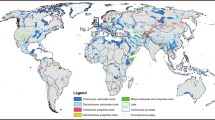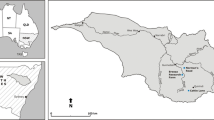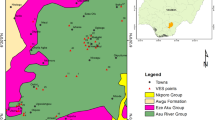Abstract
A regional lacustrine aquitard covers the main aquifer of the metropolitan area of Mexico City. The aquitard’s hydraulic conductivity (K′) is fundamental for evaluating the natural protection of the aquifer against a variety of contaminants present on the surface and its hydraulic response. This study analyzes the distribution and variation of K′ in the plains of Chalco, Texcoco and Mexico City (three of the six former lakes that existed in the Basin of Mexico), on the basis of 225 field-permeability tests, in nests of existing piezometers located at depths of 2–85 m. Tests were interpreted using the Hvorslev method and some by the Bouwer-Rice method. Results indicate that the distribution of K’ fits log-Gaussian regression models. Dominant frequencies for K’ in the Chalco and Texcoco plains range between 1E−09 and 1E−08 m/s, with similar population means of 1.19E−09 and 1.7E−09 m/s, respectively, which are one to two orders of magnitude higher than the matrix conductivity. In the Mexico City Plain the population mean is near by one order of magnitude lower; K’=2.6E−10 m/s. The contrast between the measured K’ and that of the matrix is attributed to the presence of fractures in the upper 25–40 m, which is consistent with the findings of previous studies on solute migration in the aquitard.
Résumé
Un imperméable régional d’origine lacustre recouvre le principal aquifère de la zone urbaine de la ville de Mexico. La conductivité hydraulique K′ de cet imperméable est fondamentale pour évaluer la protection naturelle de l’aquifère, contre les différents contaminants présents en surface, et sa réponse hydraulique. Cette étude analyse et les variations de K′ dans les plaines de Chalco, Texcoco et Mexico (trois des six anciens lacs qui existaient dans le Bassin de Mexico), sur la base de 225 essais de perméabilité sur le terrain, réalisés en grappes dans des piézomètres existants entre 2 et 85 m de profondeur. Les essais ont été interprétés avec la méthode de Hvorslev et certains avec la méthode de Bouwer-Rice. Les résultats indiquent que la distribution de K′ s’ajuste à des modèles de régression log-gaussiens. Les valeurs de K′ les plus fréquentes dans les plaines de Chalco et de Texcoco sont entre 1E−09 et 1E−08 m/s, avec des moyennes similaires de 1.19E−09 et 1.7E−09 m/s respectivement, qui sont d’un ou deux ordres de grandeurs supérieures à la conductivité de la matrice. Dans la plaine de Mexico, la moyenne est proche d’un ordre de grandeur en moins, avec 2.6E−10 m/s. Ce contraste entre le K′ mesuré et celui de la matrice est attribué à la présence de fractures dans les 25–40 m supérieurs, ce qui est en accord avec les études précédentes sur la migration de solutés au travers de l’imperméable.
Resumen
El acuífero principal del Área Metropolitana de la Ciudad de México está recubierto por un acuitardo regional lacustre, cuya conductividad hidráulica es fundamental para evaluar la protección natural de las aguas subterráneas contra los contaminantes presentes en superficie y su respuesta hidráulica. Este estudio analiza la distribución y variación de dicha conductividad en las llanuras de Chalco, Texcoco y Ciudad de México (tres de los seis lagos que existían al principio en la Cuenca de México) a partir de 225 ensayos de campo en piezómetros múltiples existentes, ubicados entre 2 y 85 m de profundidad. La interpretación de los ensayos se ha realizado mediante el método de Hvorslev y—algunos—el de Bouwer-Rice. Los resultados indican que la distribución de la conductividad se ajusta a modelos de regresión lognormales. Las frecuencias dominantes en las Llanuras de Chalco y Texoco están comprendidas entre 1−9 y 10−8 m/s, con medias de población similares de 1.19×10−9 y 1.70×10−9 m/s, respectivamente, que son dos órdenes de magnitud mayores que el valor de la matriz. En el Llano de México, la media es casi un orden de magnitud inferior (2.60×10−10 m/s). Se atribuye este contraste entre la conductividad hidráulica medida y la de la matriz a la presencia de fracturas en el tramo superior situado entre 25 y 40 m, cosa que es coherente con estudios previos de migración de solutos en el acuitardo.





Similar content being viewed by others
References
Bouwer H, Rice R-C (1976) A slug test method for determining hydraulic conductivity of unconfined aquifers with completely or partially penetrating wells. Water Resources Res 12(3):423–428
Bradbury K-R, Muldoon M-A (1990) Hydraulic conductivity determinations in unlithified glacial and fluvial materials. In: Nielsen D-M, Johnson A-I (eds) Ground water and vadose zone monitoring. American Society for Testing and Materials, Philadelphia, pp 138–151
Bribiesca-Castrejón J-L (1960) Hidrología histórica del Valle de México (Historic hydrology of the Valley of Mexico). Ingeniería Hidráulica, México, vol 14(1), pp 107–125
Carrillo N (1947) Influence of artesian wells in the sinking of Mexico City. Comisión Impulsora y Coordinadora de la Investigación Científica, Anuario 47. In: Volumen Nabor Carrillo. Secretaría de Hacienda y Crédito Público, México, 1969, pp 7–14
DDF (1997) Operación de las celdas de evaporación y experimentación ubicadas en la tercera y cuarta etapas de Bordo Poniente (Operation of the evaporation-experimentation cells located in the third and fourth stages of Bordo Poniente). Internal Rep Departamento del Distrito Federal, México, 65 pp plus figures and tables
Durazo J, Farvolden R-N (1989) The groundwater regime of the Valley of Mexico from historic evidence and field observations. J Hydrol 112:171–190
Fredericia J (1990) Saturated hydraulic conductivity of clayey tills and the role of fractures. North Hydrol 21:119–132
Freeze A, Cherry JA (1979) Groundwater. Prentice Hall, Englewood Cliffs, NJ, USA
Hansen R (1990) Lake deposits from Chalco Basin sediment description and first results from the core a/b. In: Abstr Vol Primer Simp El Cuaternario en México. México
Herrera I, Alberro J, León J-L, Chen B (1974) Análisis de asentamientos para la construcción de los lagos del Plan Texcoco (Analysis of land subsidence for the lake construction at the Texcoco Plan). Instituto de Ingeniería, Universidad Nacional Autónoma de México, Rep 340, 113 p
Hvorslev M-J (1951) Time lag and soil permeability in groundwater observations. Waterways Exp Stat Corps Eng, US Army, Vicksburg, Mississippi, Bull 36, 50 p
INEGI, INE (2000) Indicadores de desarrollo sustentable en México (Indicators for sustainable development in Mexico). Instituto Nacional de Estadística, Geografía e Informática y el Instituto de Ecología, 5 June 2000
Keller C-K, Van der Kamp G, Cherry J-A (1986) Fracture permeability and groundwater flow in clayey till near Saskatoon, Saskatchewan, Canada. Can Geotech J 23:229–240
Keller C-K, Van der Kamp G, Cherry J-A (1988) Hydrogeology of two Saskatchewan tills. I. Fractures, bulk permeability, and spatial variability of downward flow. J Hydrol 101:97–121
Marsal R-J (1969) Development of a lake by pumping-induced consolidation of soft clays. In: Volumen Nabor Carrillo. Secretaría de Hacienda y Crédito Público, México, vol 11, pp 229–266
Marsal RJ, Mazari M (1959) The subsoil of Mexico City. Facultad de Ingeniería, Universidad Nacional Autónoma de México, México, two vol
Marsal R-J, Mazari M (1990) Desarrollo de la mecánica de suelos en la Ciudad de México (Evolution of soil mechanics in Mexico City). In: El subsuelo de la Cuenca del Valle de México y su relación con la ingeniería de cimentaciones a cinco años del sismo. Soc Mexicana Mecánica Suelos México 1:3–24
Mesri G, Rokhsar A, Bohor B-F (1975) Composition and compressibility of typical samples of Mexico City clay. Geotechnique 25(3):527–554
NRC-AIC-ANI (1995) Mexico City’s water supply (in Spanish and English). National Research Council, Académia de la Investigación Científica, Academia Nacional de Ingeniería. National Academic Press, Washington, DC
Ortega-Guerrero M-A (1993) Origin and migration of pore water and salinity in the consolidating Chalco aquitard, near Mexico City. PhD Thesis, University of Waterloo, Ontario, Canada
Ortega-Guerrero M-A (1996) Variability of the coefficient of consolidation of the Mexico City clayey sediments on spatial and time scales. Bull Int Assoc Eng Geol Paris 54:125–135
Ortega-Guerrero M-A, Farvolden R-N (1989) Computer analysis of regional groundwater flow and boundary conditions in the Basin of Mexico. J Hydrol 110:271–294
Ortega-Guerrero M-A, Cherry J-A, Rudolph D-L (1993) Large-scale aquitard consolidation near Mexico City. Ground Water 31(5):707–718
Ortega-Guerrero M-A, Rudolph D-L, Cherry J-A (1999) Analysis of long-term land subsidence near Mexico City: field investigations and predictive modeling. Water Resources Res 25(11):3327–3341
Peralta R, Fabi R (1989) Sobre el origen de algunas propiedades mecánicas de la formación arcillosa superior del Valle de México (About the origin of some mechanical properties of the shallow clayey formation in the Valley of Mexico). In: Simp Tópicos Geológicos de la Cuenca del Valle de México. Sociedad Mexicana de Mecánica de Suelos, México
Pitre C-V (1994) Analysis of induced recharge from a waste canal through fracture clays in Mexico City. MSc Thesis, University of Waterloo, Ontario, Canada
Reséndiz D, Solana J (1969) The short-term stability of open excavations in the Mexico City clay. In: Volumen Nabor Carrillo. Secretaría de Hacienda y Crédito Público, México, vol 8, pp 203–227
Rudolph D-L, Frind E-O (1991) Hydraulic response of highly compressible aquitards during consolidation. Water Resources Res 27(1):17–30
Rudolph D-L, Cherry J-A, Farvolden R-N (1991) Groundwater flow and solute transport in fracture lacustrine clay near Mexico City. Water Resources Res 27(9):2187–2201
Ruland W-W, Cherry J-A, Feenstra S (1991) The depth of fractures and active groundwater flow in a clayey till plain in Southwestern Ontario. Ground Water 29(3):405–417
SARH-CAVM (1981) Boletin de Mecánica de Suelos 1974–1977 (Bulletin of Soil Mechanics). Secretaría de Agricultura y Recursos Hidráulicos-Comisión de Aguas del Valle de México, México, vol 8
SMMS (1978) El subsuelo y la ingeniería de cimentaciones en la Ciudad de México (Underground and engineering cementations in México City). Simp Sociedad Mexicana de Mecánica de Suelos México
Urrutia-Fucugauchi J, Lozano-García S, Ortega-Guerrero B, Caballero-Miranda M, Hansen R, Böhnel H, Negendank J-F-W (1994) Palaeomagnetic and palaeoenvironmental studies in the southern Basin of Mexico. I. Volcanosedimentary sequence and basin structure of Chalco Lake. Geofís Int 33(3):421–430
Van der Kamp G (2001) Methods for determining the in situ hydraulic conductivity of shallow aquitards—an overview. Hydrogeol J 9:5–16
Vazquez SE (1995) Modelo conceptual hidrogeológico y características hidráulicas del acuífero en explotación en la parte meridional de la Cuenca de México (Hydrogeologic conceptual model and hydraulic characteristics of the exploitation aquifer in the southern part of the Basin of Mexico). MSc Thesis, Universidad Nacional Autónoma de México
Zawadsky A (1996) Investigations regarding the origin and hydrologic activity of a large sediment-filled fissure in fractured lacustrine clay near Mexico City. MSc Thesis, University of Waterloo, Ontario, Canada
Acknowledgments
The authors wish to thank the Consejo Nacional de Ciencia y Tecnología, CONACyT (National Council for Science and Technology), for granting funds for this project, no. 3454P-T, under the direction of Adrián Ortega. A scholarship to Carlos Vargas is gratefully acknowledged.
Author information
Authors and Affiliations
Corresponding author
Rights and permissions
About this article
Cite this article
Vargas, C., Ortega-Guerrero, A. Fracture hydraulic conductivity in the Mexico City clayey aquitard: Field piezometer rising-head tests. Hydrogeology Journal 12, 336–344 (2004). https://doi.org/10.1007/s10040-003-0302-4
Received:
Accepted:
Published:
Issue Date:
DOI: https://doi.org/10.1007/s10040-003-0302-4




